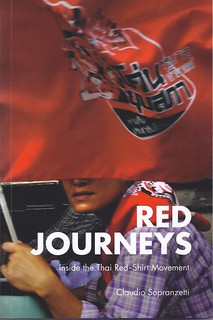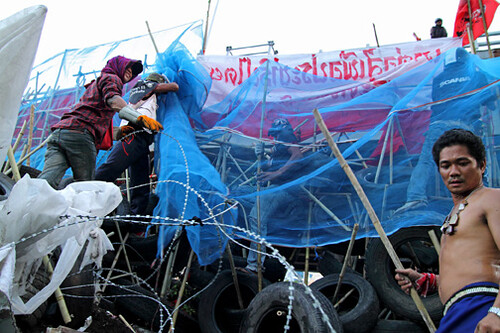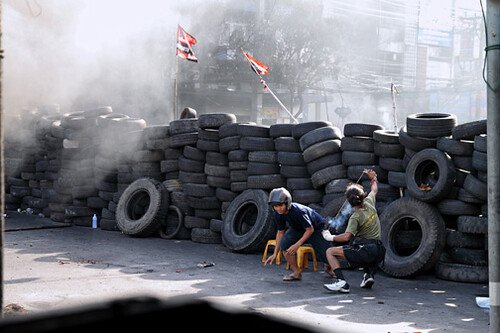Claudio Sopranzetti, Red Journeys: Inside the Thai Red-Shirt Movement. Chiang Mai, Silkworm Books, 2012. xiv + 131pp.
At the time he wrote this memoir, Claudio Sopranzetti was doing fieldwork in Thailand for his dissertation in anthropology. Based on his interactions with some of the 200,000 motorcycle taxi drivers operating semi-legally in Bangkok, his study focuses on mobility and politics. Many of the taxi drivers are from the northeast, a region populated by people of Lao descent and historically one of the most disadvantaged parts of the country. The Lao cultivators and petty traders, who migrate to the capital to work in services such as driving motorcycle taxis, have long suffered from the disparaging attitudes of wealthy, urban people who view them as country bumpkins and harbour an engrained fear of an empowered labour force.

The northeast as well as the north supported the rise of Thaksin Shinawatra, Thailand’s most electorally successful prime minister from 2001-2006 until he was ousted by a military coup. Mr. Thaksin is now in exile, a puppet master governing from abroad through Yingluck Shinawatra, the present prime minister and a former businesswoman with no previous political experience who is his younger sister. Born in the north, Thaksin himself is a scion of the wealthy, urban upper class, but he used the riches he had amassed in his business dealings to build a formidable political machine that came to so dominate Thailand’s political system that his party monopolised the parliament.
One of the keys to Thaksin’s success was his populism. His policies – inexpensive universal health care, grants to villages to kick-start community projects – struck a chord with sectors of society missing out on a share of the country’s prosperity. Thaksin is not always a hero to all these hard-scrabble people. They can spot the autocratic tendencies in his character even if they acknowledge that the media tycoon appears to defend democracy. A taxi-driver tells Sopranzetti, “You know, I don’t like Thaksin either, but now it is clear Thaksin was just a tool. This is not about him anymore. I didn’t like him. But he had good policies” (51). An old book seller, hawking the classics of Thai radicalism and the staples of Marxism from Marx himself to Rosa Luxemburg, says emphatically, “This is class war, pure and simple.” The book stall is set up in the shadow of one of Bangkok’s sumptuous shopping malls where Gucci, Louis Vuitton and Versace shops mark a place of exclusion and unequal access to resources.
The motorcycle taxi drivers dart and weave through the city’s infamous traffic congestion. Carrying commuters, supplies, and news through the city’s labyrinthian capillaries, they inch their way down narrow lanes crowded with vendors and shoppers. The taxi drivers are the life-blood of the capital, the very embodiment of mobility in the polycentric megalopolis that has challenged urban planners for many decades. Their knowledge of the city’s geography gives the drivers status as “owners of the map.” Sopranzetti plays the embedded journalist and inserts himself into their daily routines to find out what they do, who they talk to, and what they think about politics. The motility of the drivers’ vehicles is a metaphor for their desires for upward social mobility, if not for them in their own lifetimes, then for their children through formal education that will bring greater job security and higher incomes to the next generation. Among the ten countries in the Southeast Asian regional grouping known as ASEAN, Thailand has the greatest income inequality. Conversations with the motorcycle taxi drivers provide Sopranzetti with the refracting optics through which he apprehends the needs, desires and aspirations of people striving to better themselves.
In early 2010 in a political standoff against the incumbent government, which was orchestrated and funded by Thaksin from abroad, needs, desires and aspirations are given voice in a mass protest that shuts down the centre of Bangkok, first at the iconic Democracy Monument in the old part of the city, and later in the business heart of the capital. There the Red Shirts establish a camp fortified with barricades made of tires and sharpened bamboo poles that look both fearsome and frail. The camp is a city within a city, complete with pharmacies, kitchens, make-shift dormitories, and monks’ tents. Sopranzetti follows the motorcycle taxi drivers into the protest movement that paralyses the capital. The experience consumes his mental and physical energies for an entire month.
 Courtesy of Nick Nostitz
Courtesy of Nick Nostitz
To keep sane and knowing the historic import of what he is witnessing, Sopranzetti is compelled by the emotions of the moment to say something about an event that does not fit into conventional academic formats. His visual, olfactory and sonic senses are in overdrive, and he begins to keep a diary of what he sees, smells and hears. He then blogged his observations and reflections. Red Journeys is the result, a work that has been justifiably praised as “a brilliant little book – moving, eye-opening, unsettling,” and conveying “the muddle of hope and fear” experienced by those taking part in the protests.* Maps of Bangkok help to orient the reader, and each chapter begins with a black and white front page of The Nation, a Bangkok daily. The book does not have the reference apparatus and bibliography of a research publication. It is, after all, an informal memoir, a book out of a blog, and cost factors have presumably produced this rather austere publication. Googlers wanting graphic images with plenty of red can help themselves on the internet. I do think that reference to some of Sopranzetti’s comrades in reporting, such as the photo-journalist Nick Nostitz, would have offered useful comparisons to Red Journeys.** The meaning of “Father, where are you?” inscribed on a huge cloth hanging from a bridge is lost on newcomers to Thai politics unaware that the plaintive (or sarcastic?) question refers to the present monarch.
Scattered throughout Sopranzetti’s story are nuggets of sharp observation and insight, as when he observes that soldiers sent to discipline the crowds stand eye-to-eye with the protestors of the same age, both sides armed with conviction and the certainty of being in the right, “the same exact eyes on both sides – the country looking at itself” (62). He hears rumours that resist being assembled into a coherent narrative, yet he witnesses a version of history becoming fixed, “a history of violence and sacrifice, of state repression and personal heroism” (43). He declines to hazard opinions about things that are murky with conspiracy and foreboding. Who, if anyone, has control of ordnance in the Red Shirt camp? Who are the men in black said to be a third hand? Whose third hand? Who torches the capitalist icons as the Red Shirt camp is dispersed? As the story moves inevitably and inexcusably towards its violent denouement, Sopranzetti documents the mixture of tension, fear, excitement and boredom that grips the protestors. The author himself is bored with the endless, repetitive speeches blasted at full volume from loudspeakers at all hours of the day and night. “I appreciate their resilience,” he wryly remarks, “but I do not think I can stand another night of the same discourses” (83). Adding to the din is the voice of Thaksin energising the crowds via video link from afar, instructing them to hold their ground, denounce the power elite, and force the government from office.
This particular episode in the country’s confrontational politics ends in a bloody battle. The chaos and inconvenience of the huge protest site and the unshakeable demands of the Red Shirts provoke the government to use extreme force to break up the camp and disperse the protestors, an action that results in more than ninety fatalities, and injuries, some of them horrific, to over 2,000 people. Sopranzetti learns how to stay clear of danger by heeding the advice of wise heads and minimising risky moves, but even so, it is an edgy story. A Japanese TV cameraman and an Italian photo-journalist were fatally shot during the disturbances. The protestors know how to decode the sounds of army weaponry and teach the anthropologist to identify the sniper’s rifle by its short dry sound, the grenades by their loud echoes. The battle is one-sided; David resorts to home-made Molotov cocktails, burning tyres, slingshots and firecrackers against Goliath’s rocket-propelled grenades and tanks. The course of the fighting is impossible to follow at ground-level. Sopranzetti and the protestors understand less of what is happening in front of their eyes than a viewer watching CNN in New Delhi or the BBC in London. The protestors are foot soldiers fighting on the streets with only a blurred sense of the war raging above them.
 Courtesy of Nick Nostitz
Courtesy of Nick Nostitz
As the army finishes its sweeps, arsonists set fire to shopping malls, bank branches, 7-Elevens and telephone booths along the protest site. Dense black clouds rise above the city. Looking in wonderment at the burnt-out shell of Central World, one of Bangkok’s palaces of capitalism, Sopranzetti concedes that words fail him in trying to describe the enormity of the event. Language is defeated. He manages to craft one last word-picture: the middle section of Central World has just vanished, “as if a giant spoon had scooped away this delight of Bangkok’s landscape” (131). His Thai companion says it is too dangerous to hang around any longer, and they hurry away.
Note:
* Chris Baker, “Burning Resentments, The Clashes of April-May 2010 Told from the Street Level,” Bangkok Post, 14 May 2012.
** Nick Nostitz, Red vs. Yellow, vol. 1, Thailand’s Crisis of Identity (Bangkok: White Lotus, 2009) and vol. 2, Thailand’s Political Awakening (Bangkok: White Lotus, 2011).
Reviewed by Craig J. Reynolds
Published originally on Prachatai (English)
23 February 2013




